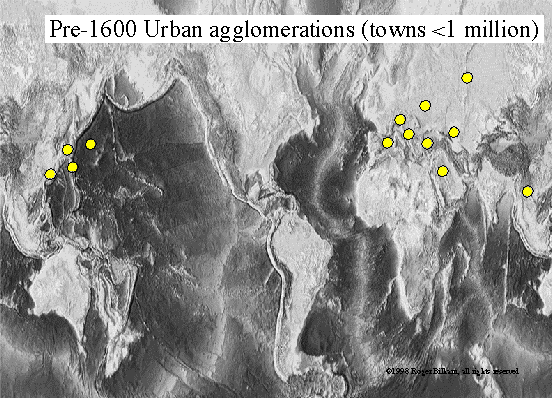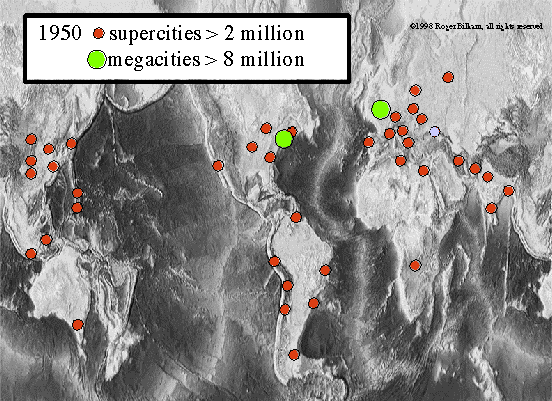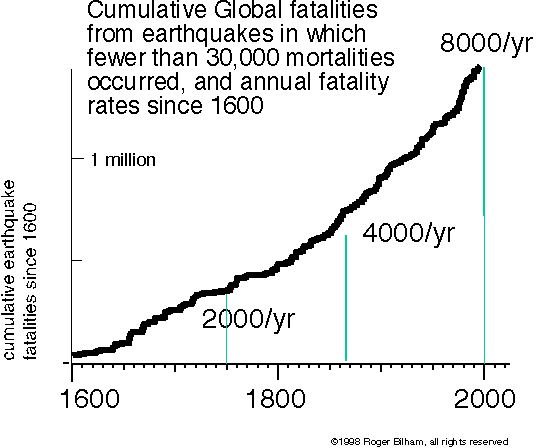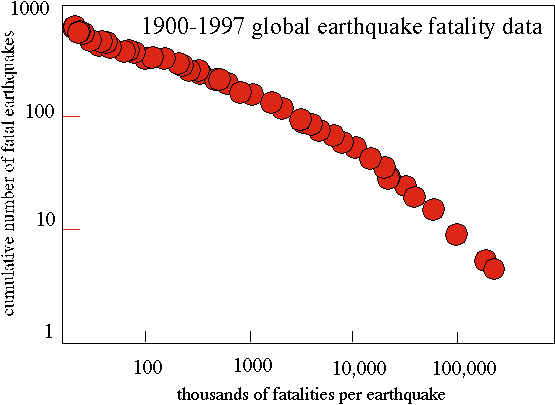
The following sequence is available for teaching purposes as a high resolution CD Powerpoint file with explanatory notes.

Global earthquake risk has more than quadrupled in the past century as a result of global urbanization. The map above shows cities with populations exceeding 200,000 in 1600. For more than 3000 years the size of city populations was regulated by diseases within them.

With the advent of improved medicine in the 18th century city populations grew rapidly, fueled by an influx of excess farmers and by a new imbalance between birth rates and death rates. Supercities (with populations exceeding 2 million) developed in the late 19th century and by 1950 there were two megacities (London and New York with populations exceeding 8 million).

By the year 2000 there will be and more than 140 supercities (not all shown) and 27 megacities. The total urban population by 2050 may exceed 5 billion people, (roughly half the 2050 world total, and equal to the year 1997 world total population).

Almost 8 million earthquake related deaths have occurred in the past 1000 years. This map illustrates that many of these deaths occur on the world's tectonic plate boundaries where tectonic plates collide. Most of these catastrophes have occurred where large cities coincide with the Alpine/Himalayan, Andes and East Asian seismic belts. If this map is compared to the supercity distribution on the previous page, it will be noted that more than half of the world's supercities are located in places where future damage from M>7.5 earthquakes is inevitable.

On average earthquakes kill 5000-8000 people/year in moderate events (<30,000 deaths/event). The linearity in the graph above permits the fatality rate from these moderate earthquakes to be forecast. It is currently about 8 thousand deaths a year. This rate has doubled twice in the past 250 years. However, the true fatality annual fatality rate is much higher if truly catastrophic earthquakes (earthquakes where more than 30,000 are killed per earthquake) are included.

This graph illustrates the intuitive result that there are many earthquakes that result in small numbers of dead and proportionally fewer that cause large death tolls. However, the linearity of the graph is alarming. It implies that there is a possibility of an earthquake causing 1 million fatalities once each century (project the line to the lower right hand side of the graph).
Just how catastrophic could a future urban earthquake be?
The destructiveness of infrequent large fatality earthquakes is aggravated by the growth of large numbers of urban targets. Not only are there more supercities, but they are larger than ever before. The statistic manifest in the above graph shows that, if a suitably sized target-city exists (e.g. an urban agglomeration exceeding 9 million), an earthquake with 3 million fatalities can occur about once every 150 years. The early 21st century development of 27 megacities provides many new target-cities.
Earthquakes don't kill people
......buildings do.
With the exception of tsunamis (earthquake tidal waves) and earthquake-triggered landslides, most earthquake related fatalities are caused by the collapse of people's homes upon them, or from fires that develop after earthquakes. A doubling in world population (6 billion -> 12 billion) is expected in the next 100 years. Half of the world's supercities and many newly developing megacities are located in seismically hazardous locations where new housing starts are at an all-time high. A simple calculation shows that 1 billion new housing starts are expected in the next few decades. These are the houses that will pose a future threat to the next generation of urban dwellers. Now is the time to prepare for future urban earthquakes. Earthquake resistant construction costs only 10% more than nonresistant construction.